One of the biggest adjustments I had to make when I lived in Japan was dealing with smoking. For most of my adult life, a smoking ban in the UK meant that when I went to bars, clubs, or restaurants, I could enjoy myself in a smoke free environment. Almost everyone I knew was a non-smoker. Since I have asthma, smoking was never something I wanted to take up. My lung capacity is bad enough as it is.
In comparison, it seemed like most of my friends and co-workers in Japan smoked. Even when I went out to eat with friends who didn't smoke, there would often be other restaurant customers who smoked, filling the air with a grey haze. After every enkai, I always had a shower to wash the smell out of my hair, no matter how late I got home.
I even knew someone who took up smoking in Japan, even though she had quit in her home country. She said that stress, the influence of her Japanese colleagues, and the fact that cigarettes were so much cheaper in Japan thanks to low taxes broke her resolve.
However, despite my personal dislike for cigarettes, even I can recognise that the Japanese tobacco industry has given the world something wonderful. I'm talking about the beautiful, poetic and funny smoking manners posters.
If you have noticed…
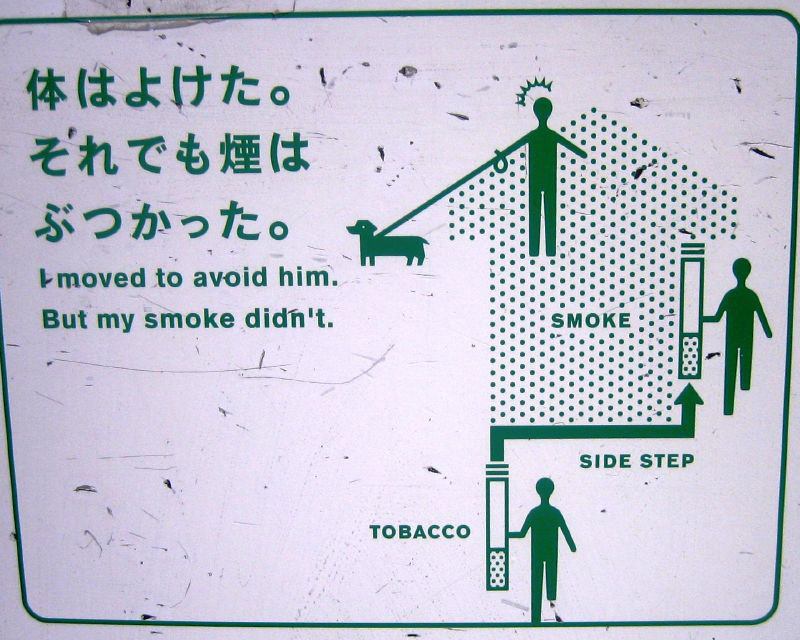
If you visit Japan, your eye will probably be caught by the simple design of the smoking manners posters. Using only two colours, green on white, the posters illustrate situations and moral quandaries. The illustration is accompanied by a line or two of text in Japanese and English. The illustrations are labeled only in English, possibly capitalising on the "cool" image of English in advertising. Reading them feels like reading poetry sometimes. The ads seem to owe something to Japanese styles of poetry like the haiku.
"The fire disappears beneath his shoe. Unfortunately, the butt still remains."
One of the elements of many classic haiku is a shift in perspective using a line break. Many of the posters employ a similar technique, with two sentences that shift your point of view. Others put smoking in a new perspective.
"I carry a 700°C fire in my hand with people walking all around."
They don't state rules, but are designed to make people think about their actions. There is definitely a sense of humour too.
"Don't smoke in a crowd. Coats are expensive."
Some pose questions.
"Tossing out cigarette butts because others did? Is that a good reason?"
They don't tell you the answer, but the implication is clear. The tag line of the adverts is
- あなたが 気づけばマナーは 変わる。
- If you have noticed, your manners change.
There is a lightness of touch that makes these posters strangely affecting.
…your manners change
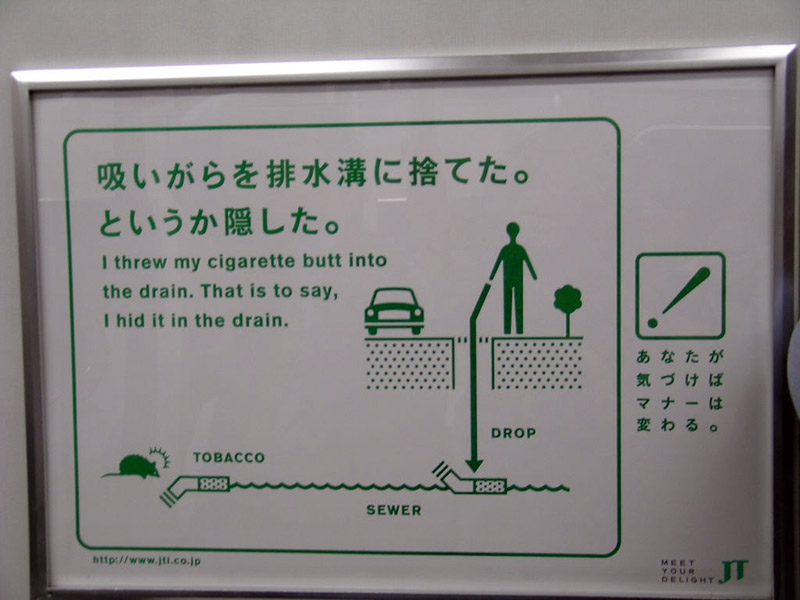
There are some common themes the posters address; throwing away cigarette butts, being aware of secondhand smoke, burning people and things, caring for Japan's nature, and the usefulness of portable ash trays. Every season a new batch of posters is released. You can view a gallery of all the posters here. My favourites are the winter ones I spotted at the Sapporo Yuki Matsuri.
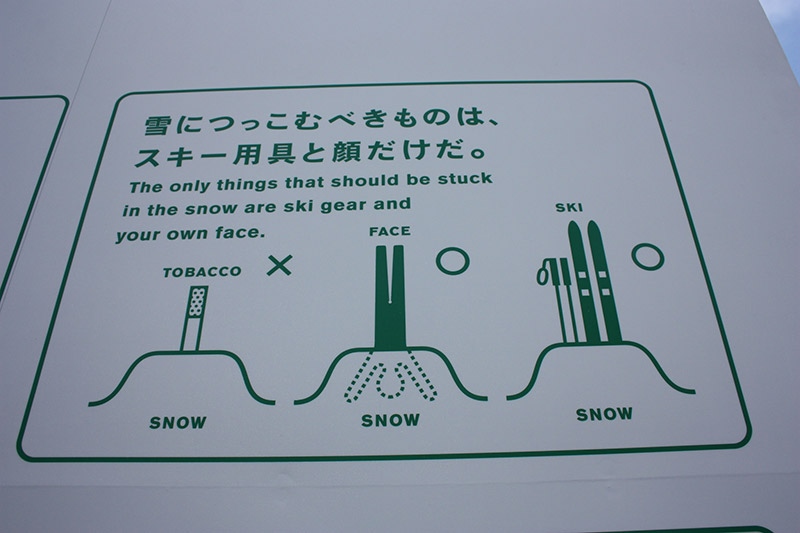
I've stuck my face in plenty of snow and was very glad never to see any cigarettes in there with me, so maybe the posters worked. I spotted this poster in the middle of Oodori, the street that famously holds the huge snow sculptures that you've probably seen. Specifically, the posters covered the side of a smoking area that had been set up to separate smokers from the rest of the crowds. That raises the question… who is making these posters?
Anti-Smoking or pro-Smoking Posters?
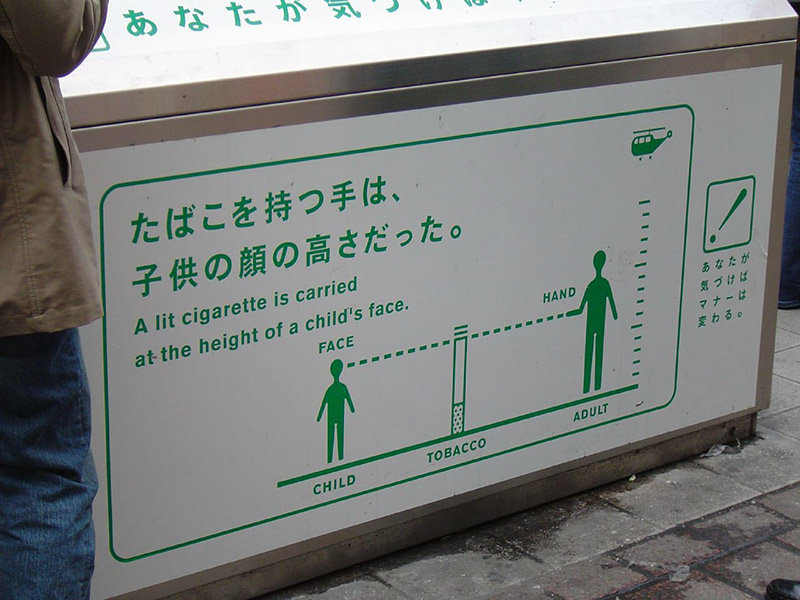
Even if you've noticed the posters, you probably don't know who makes them. The only clue is the small JT logo. That JT stands for Japan Tobacco. These posters are not an anti-smoking adverts. Did that blow your mind? I know that many people, including myself, have assumed that the posters are some kind of anti-smoking public health campaign. They are made by one of Japan's largest cigarette manufacturers and the third most profitable tobacco company in the world.
At first this might seem counterintuitive. However, when you think about it, the motives behind this campaign start to emerge. Public opinion and shame play a huge role in Japanese society. Conforming to the expectations of those around you is very important. As cigarette sales and the number of smokers in Japan decline, it is becoming less of a cultural norm. Therefore, smokers are more at risk of being judged by other non-smokers. It is in Japan Tobacco's interests both that the tobacco industry and smokers appear to be well mannered so as not to upset others. The more smokers have good manners, the less friction there will be in society, and the less likely that public opinion will turn against smoking leading to things like smoking bans, which would cut further into Japan Tobacco's profits.
Viewed from this angle, the charming posters seem quite cynical. However, regardless of the poster's motives, if they are effective then they are doing some good. Though some areas of Japan, like Kanagawa and Hyogo Prefectures are imposing smoking bans, most of the country does not seem to be following yet. In the short term, if the posters improve smokers' manners and help keep Japan clean, this is a good thing, even if they slow the decline of smoking in the long term, which is not so good.
The posters and TV adverts were made by the ad agency of Kinya Okamoto, Okakin. Okamoto is also responsible for Japan Tobacco's "Adult Training Course," with yellow posters and a similar theme to the green and yellow ones. He seemed to have corner the market in "adult" (no, not in that sense) adverts. He is also responsible for the Otona Glico (adult Glico) chocolate campaign. The link between cigarettes and adulthood is a bit easier to understand. The age of majority and the age you can buy cigarettes is 20 in Japan. This is the age when you are expected to take on adult responsibilities.
Beyond Smoking
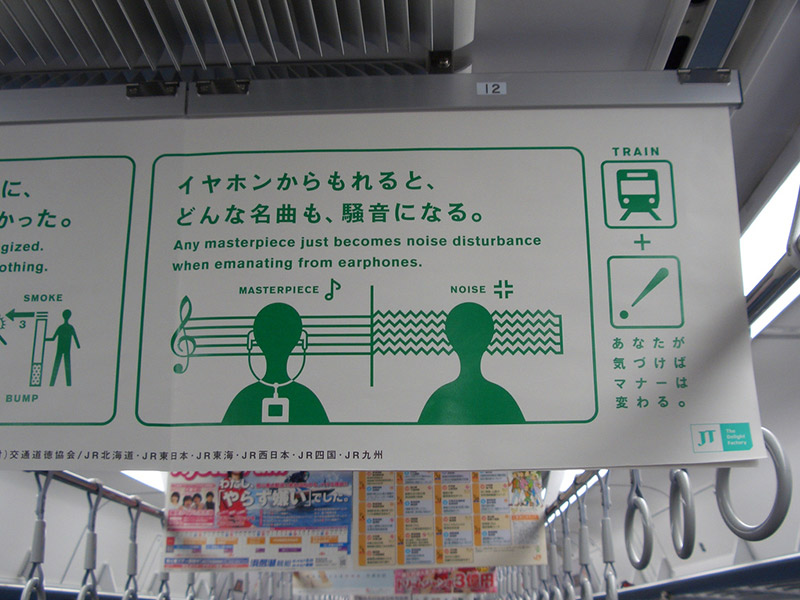
The ads have been so effective that they've been taken on by another industry. Japan Rail (JR) has a collaboration with Japan Tobacco. The JR posters have the same style as the JT posters, but address common travel faux pas. They are displayed in train carriages, often with one half addressing train manners and the other the familiar smoking manners. When I was backpacking around Japan, my eye was certainly caught by the poster about large bags.
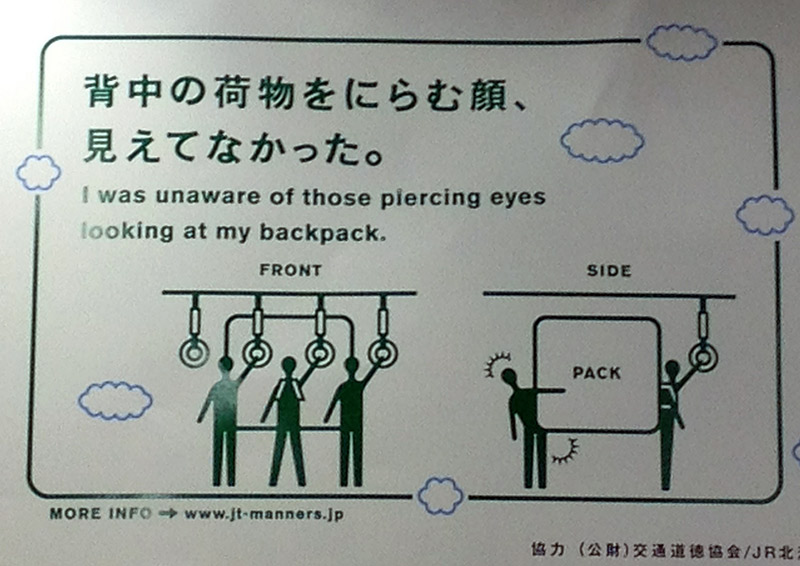
It did make me more aware of how I was carrying my bag and I adjusted my behaviour. Many foreign tourists in Japan use public transportation. If you are going on a trip, look out for them. Not only are they interesting, they can also help you mind your manners on the often very packed trains.
Studying Japanese
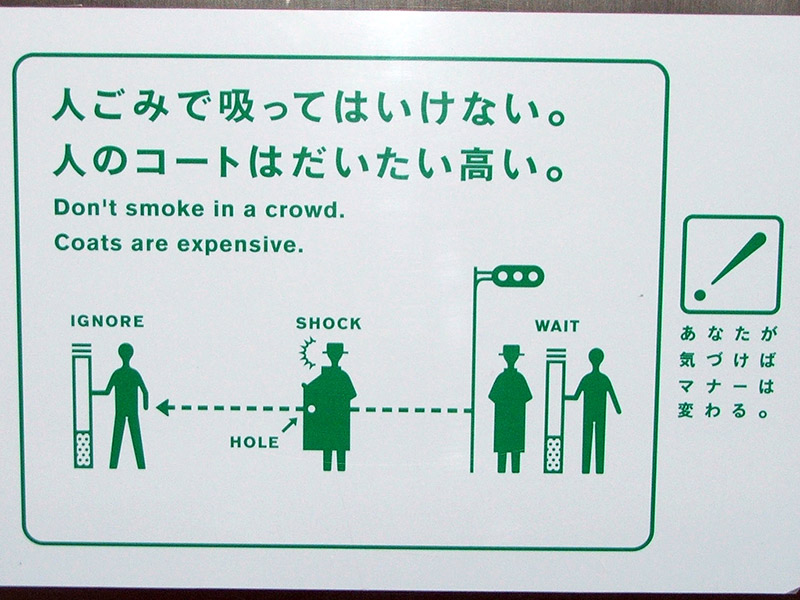
Beyond teaching manners and providing the occasional chuckle, the posters have another use. They can be used as a Japanese language learning resource in three ways. The first way is that they provide reading practice "in the wild." Coming across one of these posters is either a chance to test your reading skills by trying to read the Japanese and comparing your translation with the English on the poster, or a chance to study some new kanji. Since most of the sentences are short and only have one verb, it's easy to pick out the verb and match it to the English meaning. If you are a visual learner, the picture can help reinforce the memorisation. I liked to look at the posters as little learning resources scattered across my journeys through Japan. It was always exciting to find a new one.
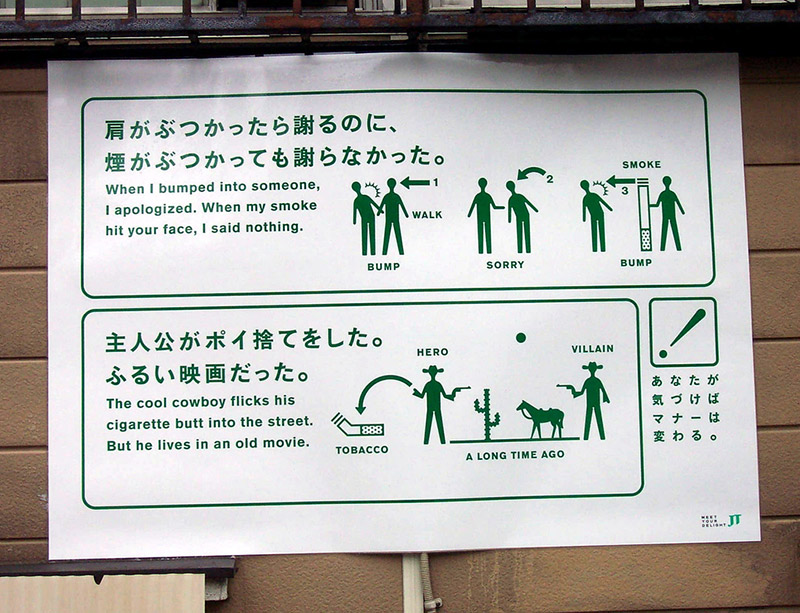
The second way the posters can help you with your Japanese goes beyond just kanji and grammar. It is fairly rare to see direct translations of Japanese into English. A good translator will keep in mind the idioms and style of the target language. That's great if you're just interested in the final translated content. It's not so great if you're trying to look behind the scenes and gain a better understanding of the original language. The English on the smoking posters sounds strange in a way that it's difficult to pin down. It's not misspelled, grammatically incorrect or "Engrish". It's just not quite how a native speaker would express the same sentiment. If you are studying Japanese, this can give you a great insight. I found that by studying these oddly direct translations, I could better understand how these statements were constructed in Japanese.
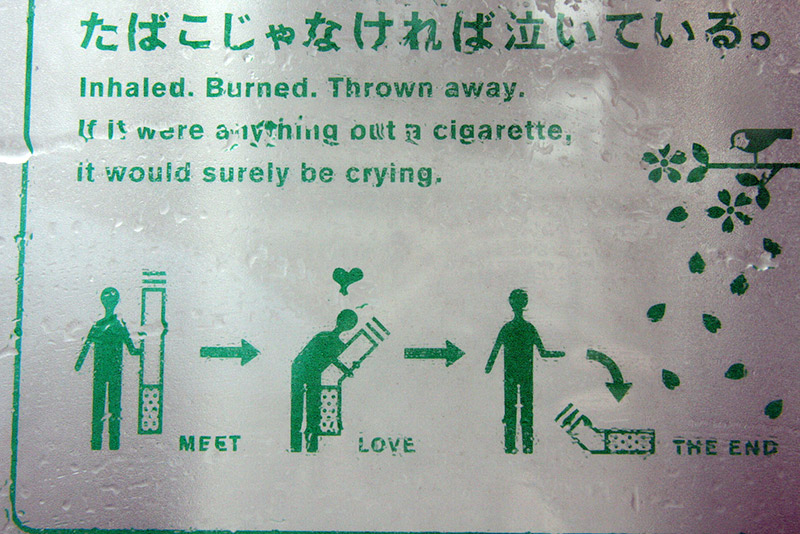
The third way they are useful builds on the second way. If we examine not just what the posters are saying, but how they are saying it, we can understand something about constructing an argument in Japanese. Anyone who has tried to teach English essay writing skills will know that an English argument and a Japanese argument are very different creatures. The smoking posters illustrate one of these differences. Rather than trying to convince people through direct command, they evoke contemplation or a emotional response. Trying to convince a Japanese person of something can sometimes be a very frustrating exercise.
When I was trying to convince teachers that students should try writing original sentences in English, it didn't matter what educational theory or evidence I cited. In the end the thing that convinced them was an anecdote. Take a look at the smoking posters and see if you can see how they make their arguments in a subtle way. What is important goes unspoken, but is implied. Learning Japanese is not just about learning the language, but also how to think in that language. You might learn what to say, but if you don't learn how to say it, you'll be missing an important component. The smoking posters can give you an insight into this aspect of Japanese that is often hard to see.
Not only useful as reading practice, the very literal English translations clearly illustrate the differences in English and Japanese go beyond the words themselves to a way of thinking. By reading these translations, we can understand something about the different thought process behind constructing a persuasive argument in Japanese.
Behind the Smokescreen

For all that I admire about the artistry and the usefulness of the smoking manners posters, we can't get away from the fact that they are part of a cute cover-up for a big health problem. The problems with smoking that the posters highlight are trivial in comparison with the real problems caused by smoking. Tobacco kills up to half of people who use it. The World Health Organisation estimates that 7,000 people are killed by second hand smoke every year in Japan. However, Japan's smoking rate is falling, part of a wider trend in developed countries. Despite the lack of a nationwide smoking ban, smoking is becoming a hotter issue in Japan. Lung cancer has overtaken stomach cancer as one of the biggest killers in Japan. The smoking salary man is an image that seems to belong in the past. The tide is turning in Japan, with increasing taxes and decreasing smoking rates, but there is still along way to go before Japan is a pleasant environment for non-smokers, despite the efforts of the smoking manners posters.
